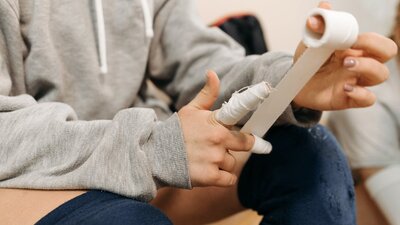Injuries can happen at any moment. Weightlifting is one of the most injury prone sports because of the excessive loads of resistance. To assure safety and a good quality practice, it’s important to have a stable foundation. Here’s how a lack of stability can lead to injuries.
Upper Body Injuries
Compound exercises can lead to rotator cuff pain or injury. The rotator cuff can be injured by internal rotation of the upper body. The most common injuries occur in the shoulders, pectoralis major tendon, and the bicep brachii.
The shoulders are responsible for joint stability. 36% of weightlifting injuries are in the shoulders, mainly due to the imbalance of rotator cuff and scapular strength (1). This is caused by a lack of variety in movement and exercise. If one repeats the same movements without implementing others, weaknesses will form. In this case, if someone works the bench press without warming up the joints, they will not have stronger shoulders. Weightlifters in pursuit of one-rep maximum lifts may already be in unsafe territory because of the unfavorable position of the rotator cuff.
The bench press is already risky for the rotator cuff. Furthermore, it can also lead to injuries in the pectoralis major tendon. The most common way people experience injury is during the contraction portion of the movement. At this point, the muscles are at their most vulnerable.
Changing the grip of compound movements can alleviate excessive force upon the rotator cuff. These apply to any upper body movements. Even squats can put pressure on the rotator cuff. It would be beneficial to alternate between back and front squats. Physical therapy that emphasizes range of motion can help to avoid stiffness and “frozen shoulder”. Failure to treat the rotator cuff could extend the symptoms for at least 6 months (2).
The safest ways to prevent this kind of injury is through proper preparation and technique. External rotation movements can prepare the upper body to open up during the contraction. This avoids an internal rounding of the torso from occurring. The bench press technique is best understood through the bar path. To summarize, as long as the bar does not fall below chest-level during contraction, the pecs and shoulders will remain safe.
The bicep brachii is also susceptible to injury because it is connected to the scapula. 90% of tendon ruptures occur in the long head of the bicep (1). This injury is commonly caused by the eccentric part of pulling movements with heavy weight, be it biceps curls or rows. Weight overload can lead to a lack of control; lifters want to control the weight, not be controlled by it. A lack of control in this area can cause elbow hyperextension in the concentric part of the movement. The hyperextension will lead to muscle tears.
This can be avoided by ending the movement right before hyperextension. Keeping a slight bend in the arms will still recruit the proper muscles for the contraction. Also, changing the grip between underhand, reverse, and neutral curls can strengthen the bicep brachii from different angles. People who experienced rotator cuff injury in the past were noticeably weaker in core stability exercises. This could apply to any neuromuscular injury, but they were tested in full-body movements specializing in rotator cuff activation (3). However, core instability can also lead to lower body injuries.
Lower Body Injuries
40.8% of weightlifters have once experienced low back pain (4). This occurs from excessive force on the lumbar spine. This will result in muscle strains, sciatica, and hernias. The two biggest culprits in the sport are deadlifts and squats. These movements require maintaining a fully erect posterior chain while holding heavy loads. The depth of muscle recruitment needed for proper form can be difficult.
The lifters who suffer from this are ones with weak hip abductors, extensors, and core muscles. The core is connected to the pelvis, spine, and kinetic chain. Exercising the stability of these areas is highly recommended. This proves that if low back pain is an issue, treating it through more compound lifts is not the correct route. Instead, the root of it can be found in the muscles connected to it.
One controlled study tested various ways to improve low back pain. Two of the best treatments were stretching and strengthening the hips and core. These therapies resulted in less pain and disability levels, along with improved balance and quality of life. In contrast, the group who only stretched had higher low back instability and hip flexibility (5).
Other alternatives to rehabilitation are wearing a lifting belt, changing sports, and swimming. The latter is known for lengthening the posterior chain and eliminating loads on the lumbar spine (4). Low back pain can set back any lifter and possibly take them out of the sport. This could lead to depression and self-esteem issues. It’s important to keep it safe by not ignoring the joints that stabilize it.
Creating Stability
Weightlifting injuries can be avoided by exercising joint and core stability. The most important areas to target are the rotator cuff, the hips, and the core. These can be worked through isolation work or practicing another sport. The more variety put towards weightlifting, the more the entire body will become more connected and stronger.
Works Cited:

